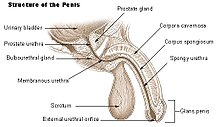Glans penis: Difference between revisions
| [pending revision] | [pending revision] |
at least, I reduced the off-topic image's size. |
|||
| Line 2: | Line 2: | ||
==Medical considerations== |
==Medical considerations== |
||
[[Image:Illu_penis.jpg|thumb |
[[Image:Illu_penis.jpg|thumb]] |
||
The meatus (opening) of the urethra is at the tip of the glans penis. In young boys who wear diapers, the meatal area of the glans penis is at risk from meatitis, meatal ulceration, and possibly meatal stenosis. [http://www.cirp.org/library/complications/freud1/] |
The meatus (opening) of the urethra is at the tip of the glans penis. In young boys who wear diapers, the meatal area of the glans penis is at risk from meatitis, meatal ulceration, and possibly meatal stenosis. [http://www.cirp.org/library/complications/freud1/] |
||
Revision as of 08:28, 23 May 2006

The glans penis is the sensitive erectile tip of the penis. It is wholly or partially covered by the foreskin, except when the foreskin is retracted, such as during sexual intercourse or masturbation while the penis is erect, or when the foreskin has been removed by circumcision.
Medical considerations

The meatus (opening) of the urethra is at the tip of the glans penis. In young boys who wear diapers, the meatal area of the glans penis is at risk from meatitis, meatal ulceration, and possibly meatal stenosis. [1]
The epithelium of the glans penis is mucocutaneous tissue.[2] Birley et al. report that excessive washing with soap may dry the mucous membrane that covers the glans penis and cause non-specific dermatitis.[3]
Inflammation of the glans penis is known as balanitis. It occurs in 3–11% of males, and up to 35% of diabetic males. It has many causes, including irritation, or infection with a wide variety of pathogens. Careful identification of the cause with the aid of patient history, physical examination, swabs and cultures, and biopsy are essential in order to determine the proper treatment.[4]
Anatomical details
The glans penis is the expanded cap of the corpus spongiosum. It is moulded on the rounded ends of the corpora cavernosa penis, extending farther on their upper than on their lower surfaces. At the summit of the glans is the slit-like vertical external urethral orifice. The circumference of the base of the glans forms a rounded projecting border, the corona glandis, overhanging a deep retroglandular sulcus, behind which is the neck of the penis.
The foreskin maintains the mucosa in a moist environment.[5] In males who have been circumcised, but have not undergone restoration, the glans is permanently exposed and dry. Contrary to widely-held belief, the glans of the circumcised penis does not develop a thicker keratinization layer.[6] Studies have shown that the glans is equally sensitive in circumcised and uncircumcised males (controversial),[7] [8] however, many males who have restored their foreskin disagree with these findings.[citation needed] The observed increase in sensitivity frequently is often attributed to the increase in moistness of the covered glans, although others have proposed the placebo effect.[9] [10]
Halata & Munger (1986) report that the density of genital corpuscles is greatest in the corona glandis,[11] while Yang & Bradley (1998) report that their study "showed no areas in the glans to be more densely innervated than others."[12]
Halata & Spathe (1997) reported that "the glans penis contains a predominance of free nerve endings, numerous genital end bulbs and rarely Pacinian and Ruffinian corpuscles. Merkel nerve endings and Meissner corpuscles are not present."[13]
Yang & Bradley argue that "The distinct pattern of innervation of the glans emphasizes the role of the glans as a sensory structure".[14]
See also
References
External links
- Freud P. The ulcerated urethral meatus in male children. J Pediatr 1947;31(4):131-41.
- Halata Z, Munger BL. The neuroanatomical basis for the protopathic sensibility of the human glans penis. Brain Research 1986;371(2):205-30.
- Halata Z, Spaethe A. Sensory innervation of the human penis. Adv Exp Med Biol 1997;424:265-6.
- Yang CC, Bradley WE Neuroanatomy of the penile portion of the human dorsal nerve of the penis. Br J Urol 1998;82(1):109-13.
